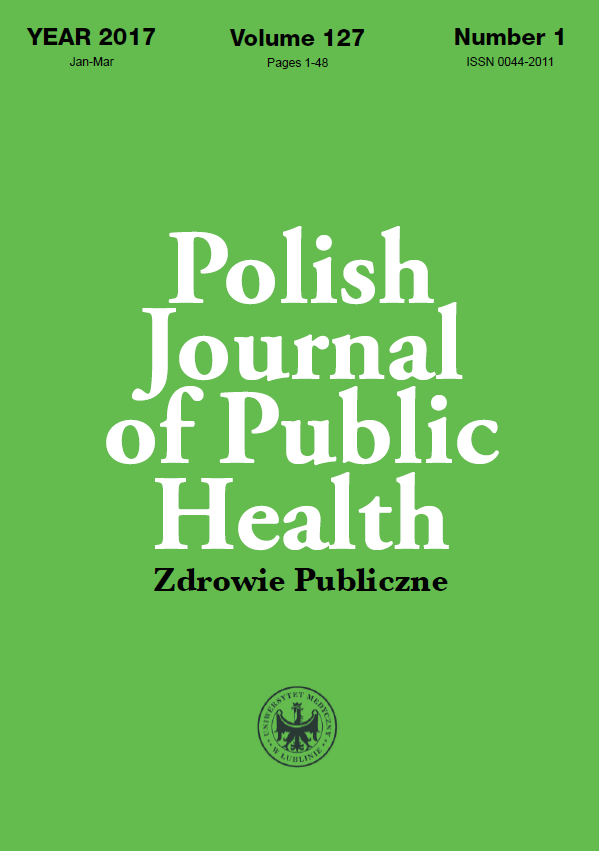First aid at the scene in the opinion of the members of Warsaw medical rescue teams
DOI:
https://doi.org/10.1515/pjph-2017-0002Słowa kluczowe:
first aid, emergency medical services, basic life supportAbstrakt
Introduction. The ability to provide first aid should be one of the basic skills of each of us.
Aim. The aim of the study was to learn the opinion of the members of Medical Rescue Teams (MRT) of the “Meditrans” Provincial Ambulance and Sanitary Transport Service (PA and STS “Meditrans”) in Warsaw on how people react in real situations threatening life or health of the injured person.
Material and methods. The study was conducted in the third quarter of 2015 on 335 members of medical rescue teams, including 77 women and 258 men, who provided medical services in the “Meditrans” Provincial Ambulance and Sanitary Transport Service MRT in Warsaw. The research tool was an anonymous questionnaire survey of own design, which consisted of 12 questions: closed, half open and one open question.
Results. The majority of respondents have encountered instances of first aid provision, but respondents assessed the frequency of such situations as low. Among the largest group of witnesses providing first aid there are the elderly and youth, who are subjected to various forms of education related to first aid provision.
Conclusions. Only continuous education and in particular, practical trainings will help people to overcome the barrier of their limitations in order to help others.
Bibliografia
1. Dz. U. 2006, nr 191, poz. 1410.
2. Dybowska I. Udzielanie pomocy to obowiązek moralny. Kronika mazowiecka; 2015;6:24-7.
3. Chemperek E, Goniewicz M, Włoszczak-Szubzda A, et al. Poziom wiedzy uczniów szkół ponadgimnazjalnych i studentów w zakresie pierwszej pomocy. MONZ. 2011;17(4):174-9.
4. Patryn R, Żysko M, Sobczyńska M. Analiza poziomu wiedzy i znajomości prawa dotyczącego zasad udzielania pierwszej pomocy wśród grup aktywnych kierowców województwa lubelskiego. Med Og Nauk Zdr. 2012; 18(4): 324-9.
5. Olejniczak D, Miciuk D, Religion U. Ocena stanu wiedzy studentów Warszawskiego Uniwersytetu Medycznego na kierunku pielęgniarstwo na temat udzielania pierwszej pomocy przedmedycznej. Piel Zdr Publ. 2013;3(2):101-10.
6. Grześkowiak M, Frydrysiak K. Wiedza młodzieży szkolnej i studentów pierwszego roku z zakresu udzielania pierwszej pomocy. Now Lek. 2007;76(5):402-5.
7. Strzyżewska K, Medrzycka-Dąbrowska W, Dąbrowski S, et al. Ocena poziomu studentów aglomeracji trójmiejskiej z zakresu udzielania pierwszej pomocy. Anest Ratow. 2012;6:41-52.
8. Greif R, Lockey AS, Conaghan P, et al. European Resuscitation Council Guidelines for Resuscitation 2015 Section 10. Education and implementation of resuscitation. Resuscitation. 2015;95:288-301. [Web of Science]
9. Kubiak K. Pierwsza pomoc – wspólna sprawa. Na ratunek. 2009;2:26-7.
10. Stebelski M. Na ratunek pierwszej pomocy. Na ratunek. 2009;2:20-5.
11. Perkins GD, Handley AJ, Koster RW, et al. European Resuscitation Council Guidelines for Resuscitation 2015 Section 2. Adults basic life support and automated external defibrillation section Collaborators. Resuscitation. 2015;95:81-99.
12. Zideman DA, De Buck EDJ, Singletary EM, et al. European Resuscitation Council Guidelines for Resuscitation 2015 Section 9. First aid. Resuscitation. 2015;95:278-87. [Web of Science]
13. Adamczyk K, Lorencowicz R, Trawka H. Znajomość zasad udzielania pierwszej pomocy osobom poszkodowanym w wypadkach drogowych. Zdr Publ. 2003;113(3/4):337-40.
14. Rasmus A, Machała W, Samborska-Sablik A. Udział świadków zdarzenia w czynnościach resuscytacyjnych. Zdr Publ. 2002;112(4):475-9.
Pobrania
Opublikowane
Numer
Dział
Licencja
Prawa autorskie (c) 2017 Polish Journal of Public Health

Praca jest udostępniana na licencji Creative Commons Attribution-NonCommercial-NoDerivatives 3.0 Unported License.


